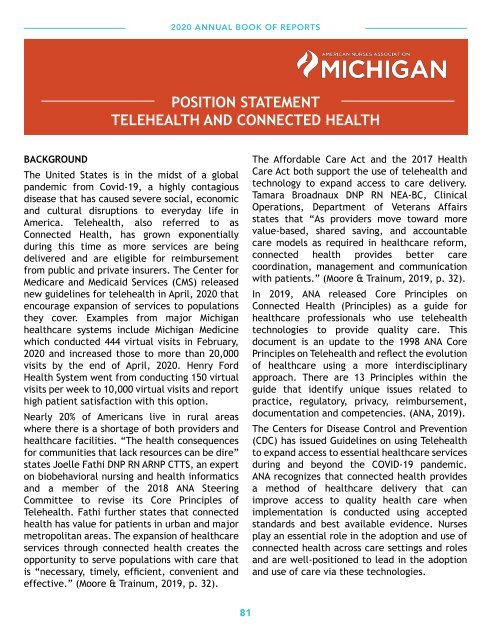ANA-Michigan - 2020 Annual Book of Reports
You also want an ePaper? Increase the reach of your titles
YUMPU automatically turns print PDFs into web optimized ePapers that Google loves.
<strong>2020</strong> ANNUAL BOOK OF REPORTS<br />
POSITION STATEMENT<br />
TELEHEALTH AND CONNECTED HEALTH<br />
BACKGROUND<br />
The United States is in the midst <strong>of</strong> a global<br />
pandemic from Covid-19, a highly contagious<br />
disease that has caused severe social, economic<br />
and cultural disruptions to everyday life in<br />
America. Telehealth, also referred to as<br />
Connected Health, has grown exponentially<br />
during this time as more services are being<br />
delivered and are eligible for reimbursement<br />
from public and private insurers. The Center for<br />
Medicare and Medicaid Services (CMS) released<br />
new guidelines for telehealth in April, <strong>2020</strong> that<br />
encourage expansion <strong>of</strong> services to populations<br />
they cover. Examples from major <strong>Michigan</strong><br />
healthcare systems include <strong>Michigan</strong> Medicine<br />
which conducted 444 virtual visits in February,<br />
<strong>2020</strong> and increased those to more than 20,000<br />
visits by the end <strong>of</strong> April, <strong>2020</strong>. Henry Ford<br />
Health System went from conducting 150 virtual<br />
visits per week to 10,000 virtual visits and report<br />
high patient satisfaction with this option.<br />
Nearly 20% <strong>of</strong> Americans live in rural areas<br />
where there is a shortage <strong>of</strong> both providers and<br />
healthcare facilities. “The health consequences<br />
for communities that lack resources can be dire”<br />
states Joelle Fathi DNP RN ARNP CTTS, an expert<br />
on biobehavioral nursing and health informatics<br />
and a member <strong>of</strong> the 2018 <strong>ANA</strong> Steering<br />
Committee to revise its Core Principles <strong>of</strong><br />
Telehealth. Fathi further states that connected<br />
health has value for patients in urban and major<br />
metropolitan areas. The expansion <strong>of</strong> healthcare<br />
services through connected health creates the<br />
opportunity to serve populations with care that<br />
is “necessary, timely, efficient, convenient and<br />
effective.” (Moore & Trainum, 2019, p. 32).<br />
The Affordable Care Act and the 2017 Health<br />
Care Act both support the use <strong>of</strong> telehealth and<br />
technology to expand access to care delivery.<br />
Tamara Broadnaux DNP RN NEA-BC, Clinical<br />
Operations, Department <strong>of</strong> Veterans Affairs<br />
states that “As providers move toward more<br />
value-based, shared saving, and accountable<br />
care models as required in healthcare reform,<br />
connected health provides better care<br />
coordination, management and communication<br />
with patients.” (Moore & Trainum, 2019, p. 32).<br />
In 2019, <strong>ANA</strong> released Core Principles on<br />
Connected Health (Principles) as a guide for<br />
healthcare pr<strong>of</strong>essionals who use telehealth<br />
technologies to provide quality care. This<br />
document is an update to the 1998 <strong>ANA</strong> Core<br />
Principles on Telehealth and reflect the evolution<br />
<strong>of</strong> healthcare using a more interdisciplinary<br />
approach. There are 13 Principles within the<br />
guide that identify unique issues related to<br />
practice, regulatory, privacy, reimbursement,<br />
documentation and competencies. (<strong>ANA</strong>, 2019).<br />
The Centers for Disease Control and Prevention<br />
(CDC) has issued Guidelines on using Telehealth<br />
to expand access to essential healthcare services<br />
during and beyond the COVID-19 pandemic.<br />
<strong>ANA</strong> recognizes that connected health provides<br />
a method <strong>of</strong> healthcare delivery that can<br />
improve access to quality health care when<br />
implementation is conducted using accepted<br />
standards and best available evidence. Nurses<br />
play an essential role in the adoption and use <strong>of</strong><br />
connected health across care settings and roles<br />
and are well-positioned to lead in the adoption<br />
and use <strong>of</strong> care via these technologies.<br />
81

















